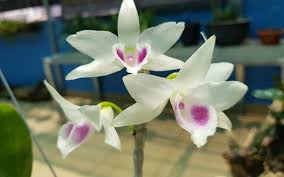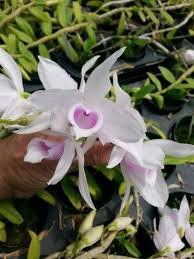
Phi Diep orchids (*Dendrobium anosmum*) are beloved for their stunning flowers and aromatic fragrance, making them a favorite among orchid enthusiasts. To ensure these exquisite plants thrive and bloom beautifully, proper nutrition is vital. Organic fertilizers offer a sustainable and effective way to provide essential nutrients without the drawbacks of synthetic options. This article will guide you through selecting and using organic fertilizers specifically for Phi Diep orchids, covering everything from understanding their nutritional needs to application techniques.
## 1. Understanding the Nutritional Needs of Phi Diep Orchids
### 1.1 Nutritional Requirements
Like all orchids, Phi Diep orchids require a balanced diet of macronutrients and micronutrients for healthy growth and flowering. The primary macronutrients include:
– **Nitrogen (N):** Essential for leaf growth and overall vegetative development.
– **Phosphorus (P):** Crucial for root development and flower production.
– **Potassium (K):** Supports overall plant health, enhances flower color, and helps resist diseases.
In addition to these, orchids also need micronutrients such as magnesium, calcium, iron, and manganese. These nutrients support various physiological functions and overall health.
### 1.2 Soil Considerations
The potting mix for Phi Diep orchids is typically well-draining, allowing for good aeration and moisture retention. Organic fertilizers work best when incorporated into this environment, as they can help improve soil structure and retain moisture while releasing nutrients slowly.
## 2. Choosing the Right Organic Fertilizer
### 2.1 Types of Organic Fertilizers
There are several types of organic fertilizers suitable for Phi Diep orchids. Each type has its benefits and can be selected based on your specific needs.
1. **Compost**
– **Description:** Decomposed organic matter, including kitchen scraps, leaves, and grass clippings.
– **Benefits:** Enriches the potting mix with nutrients and improves soil structure. It also provides beneficial microorganisms that promote healthy root development.
– **Application:** Mix into the potting medium or apply as a top dressing.
2. **Fish Emulsion**
– **Description:** A liquid fertilizer made from fish waste, rich in nitrogen and trace elements.
– **Benefits:** Provides quick-release nutrients and promotes vigorous growth, especially during the growing season.
– **Application:** Dilute with water according to package instructions and apply every 4-6 weeks during active growth.
3. **Seaweed Extract**
– **Description:** Derived from seaweed, it is rich in micronutrients and growth hormones.
– **Benefits:** Enhances root development, improves plant resilience, and stimulates flowering.
– **Application:** Mix with water and apply as a foliar spray or soil drench every 4-6 weeks.
4. **Bone Meal**
– **Description:** Made from ground animal bones, it is high in phosphorus.
– **Benefits:** Supports root growth and flower development.
– **Application:** Mix into the potting medium at planting or as a top dressing.
5. **Kelp Meal**
– **Description:** Dried and ground seaweed, rich in potassium and trace minerals.
– **Benefits:** Improves overall plant health and resilience to stress.
– **Application:** Mix into the potting mix or apply as a top dressing.
6. **Worm Castings**
– **Description:** Nutrient-rich excrement from earthworms.
– **Benefits:** Provides a balanced supply of nutrients, improves soil structure, and encourages beneficial microbial activity.
– **Application:** Mix into the potting medium or use as a top dressing.
### 2.2 Organic Fertilizer Ratings
When selecting organic fertilizers, pay attention to the N-P-K ratio (Nitrogen, Phosphorus, Potassium) on the label. A balanced fertilizer with an N-P-K ratio of approximately 3-1-2 is ideal for promoting healthy growth and flowering in Phi Diep orchids. Depending on the growth stage of your orchids, you may want to adjust the ratio:
– **For vegetative growth:** A higher nitrogen content (e.g., 5-1-2).
– **For blooming:** A higher phosphorus content (e.g., 3-5-3).
## 3. Application Techniques for Organic Fertilizers
### 3.1 When to Fertilize
The timing of fertilizer application is crucial for maximizing the benefits of organic fertilizers. Phi Diep orchids generally have two growth cycles:
– **Active Growth Phase:** Typically occurs in the spring and summer. During this time, apply fertilizers more frequently to support vigorous growth.
– **Resting Phase:** In the fall and winter, growth slows down. Reduce or eliminate fertilizer applications during this period.
### 3.2 How to Apply Organic Fertilizers
1. **Soil Incorporation**
– For granular fertilizers, mix the product into the top layer of the potting mix before watering. This method ensures even distribution of nutrients and helps prevent nutrient leaching.
2. **Top Dressing**
– Spread a thin layer of organic fertilizer (such as compost or worm castings) on the surface of the potting mix. Water thoroughly afterward to help nutrients penetrate the soil.
3. **Liquid Fertilizers**
– For liquid fertilizers like fish emulsion or seaweed extract, dilute according to package instructions and apply directly to the soil or as a foliar spray. This method allows for rapid nutrient uptake.
### 3.3 Dosage Guidelines
Follow these general dosage guidelines when using organic fertilizers:
– **Granular Fertilizers:** Use 1-2 tablespoons per pot, depending on the size of the container. Apply every 4-6 weeks during the active growth period.
– **Liquid Fertilizers:** Dilute 1 tablespoon per gallon of water for liquid fertilizers, applying every 4-6 weeks during the growing season.
## 4. Monitoring and Adjusting Fertilization
### 4.1 Observing Plant Health
Regularly monitor your Phi Diep orchids for signs of nutrient deficiencies or excesses. Look for the following symptoms:
– **Yellowing Leaves:** Indicates nitrogen deficiency.
– **Stunted Growth:** May suggest a lack of nutrients or poor soil conditions.
– **Brown Leaf Tips:** Often a sign of over-fertilization or excessive salt buildup.
### 4.2 Adjusting Fertilization Practices
Based on your observations, adjust your fertilization practices accordingly:
– If yellowing occurs, consider increasing nitrogen levels in your fertilization regimen.
– If stunted growth persists, assess your potting mix and overall care routine.
– If brown leaf tips appear, flush the potting mix with water to reduce salt buildup and decrease fertilizer frequency.
## 5. Understanding the Benefits of Organic Fertilizers
### 5.1 Environmental Sustainability
Using organic fertilizers is a more sustainable approach to gardening. They are typically made from renewable resources, reducing the environmental impact associated with synthetic fertilizers.
### 5.2 Soil Health Improvement
Organic fertilizers enhance soil health by promoting microbial activity, improving soil structure, and increasing its ability to retain moisture and nutrients. This healthy soil environment is essential for the long-term growth of Phi Diep orchids.
### 5.3 Enhanced Flavor and Aroma
Orchids nourished with organic fertilizers often display richer colors and more intense fragrances, enhancing their aesthetic and olfactory appeal.
### 5.4 Reduced Risk of Chemical Buildup
Organic fertilizers have a lower risk of chemical buildup in the potting medium, making them safer for both the plants and the environment. This reduces the likelihood of root burn and other negative effects associated with synthetic fertilizers.
## 6. Common Mistakes and How to Avoid Them
### 6.1 Over-Fertilization
Over-fertilizing is a common mistake that can lead to root burn and poor plant health. To avoid this:
– Follow dosage guidelines carefully.
– Observe your plants for signs of nutrient excess, such as brown leaf tips or slow growth.
– Flush the potting medium with water periodically to prevent salt buildup.
### 6.2 Inconsistent Application
Inconsistent fertilization can hinder the growth of Phi Diep orchids. To maintain a healthy routine:
– Create a fertilization schedule based on the orchid’s growth cycle.
– Keep a journal to track your fertilization history, noting any changes in plant health.
### 6.3 Ignoring Environmental Conditions
The effectiveness of organic fertilizers can be influenced by environmental factors such as temperature, humidity, and light. To ensure optimal results:
– Monitor the growing conditions and adjust your fertilization practices accordingly.
– Be aware of seasonal changes that may affect the orchid’s nutrient requirements.
## 7. Conclusion
Caring for Phi Diep orchids requires a thoughtful approach to fertilization, especially when choosing organic options. By understanding their nutritional needs and selecting the appropriate organic fertilizers, you can promote healthy growth and stunning blooms. Regular monitoring, consistent application, and awareness of environmental conditions are essential for successful orchid care.
Organic fertilizers not only benefit the health of your orchids but also contribute to a sustainable gardening practice. Embrace the journey of nurturing Phi Diep orchids with organic methods, and enjoy the beauty and fragrance they bring to your home or garden. With patience and care, your Phi Diep orchids can thrive and reward you with magnificent blooms year after year.


